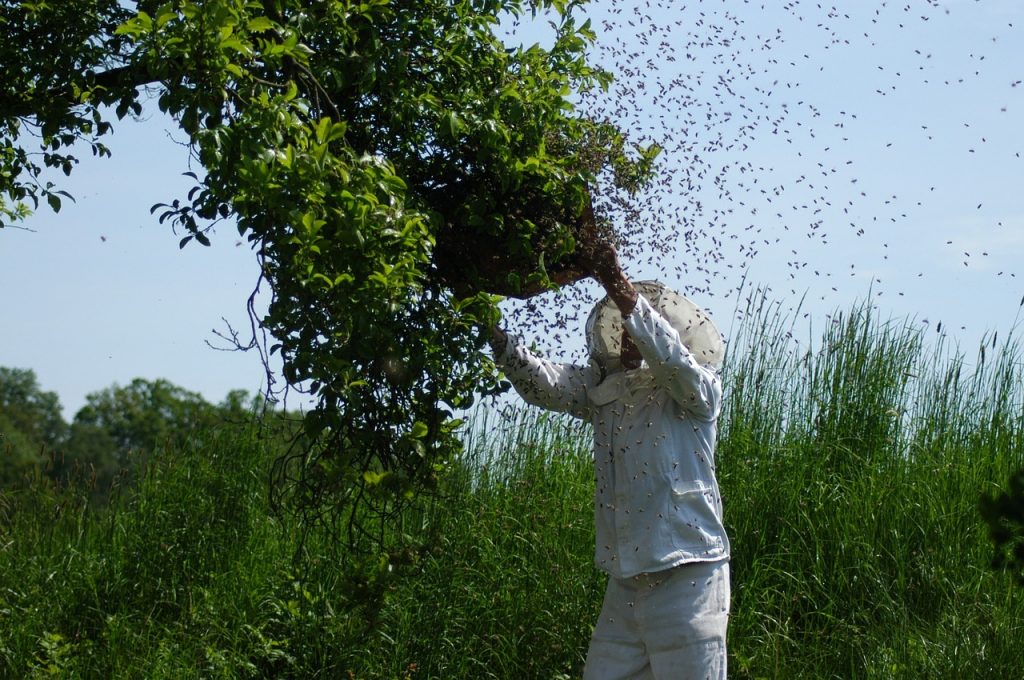What’s the Story with the Beekeeper’s Suit?

Have you ever wondered why many beekeepers wear those big white suits? You know, the ones that look like they belong on the space shuttle? Although they might not be featured on the runways of New York Fashion Week, the beekeeping suit plays an essential role in protecting the beekeeper from unpleasant bee stings.
Beekeepers perform many vital functions that help protect the honey bee population. They ensure that the bees are healthy, especially the queen bee who is responsible for producing all of the eggs, up to 2,000 per day! Beekeepers also keep an eye on potential swarming behavior, collect honey and encourage successful pollination.
The duties of the beekeeper vary throughout the year according to the seasons. In the late winter and early spring, their focus is on preparing the colony for the busy summer months. They will make sure the bees have enough food and space to expand, as well as ensure that the queen is strong. In the early summer, beekeepers get to work collecting honey. In the late summer, they prepare the bees for winter. Beekeepers sure do keep busy!
To say they get up close and personal with bees is an understatement! It is no wonder that they need to be adequately protected so they feel comfortable and safe while doing their jobs. Let’s learn a little more about the history of the beekeeping suit and the features of the modern suits you see today.
A Brief History of the Beekeeping Suit
Beekeeping is not a new phenomenon! Evidence suggests that humans were harvesting honey from bees 10,000 years ago. Depictions and records of beekeeping have been found across North Africa, Egypt, China, Greece and areas of South America.
The earliest apiarists didn’t wear any protection at all. In 16th century Europe, beekeepers developed a precursor to the modern suits we see today. Unfortunately, these suits featured a completely non-functional wicker mask. It may have protected the face and neck, but it did not allow for much visibility! Present-day apiarists wear a much more protective suit that consists of three main parts: the veil, gloves and jacket.
The Beekeeping Veil
Nobody wants a bee sting to the face or neck. That’s why beekeepers are always seen with a bee veil that covers their face, neck and shoulders. Unlike the wicker masks of the 1500s, modern bee veils are made of mesh so beekeepers can breathe and see with ease. Often, you will see experienced beekeepers wearing only a hat with an attached veil to protect themselves, without gloves and other protective clothing.
The Beekeeping Gloves
Next up are the beekeeping gloves. As we mentioned earlier, some of the more experienced apiarists don’t wear gloves to protect their hands. Their years of working with bees and their intimate knowledge of their particular colony gives them the confidence to go without protection. As you can imagine, this is not recommended! Bee gloves come in a variety of materials and thicknesses depending on the type of bees the apiarist works with. All new beekeepers should wear protective bee gloves when handling their bees.
The Beekeeping Jacket
Finally, there is the beekeeping jacket. The bee jacket can be made out of a variety of materials including cotton, nylon and layered mesh. Although some options, like cotton and nylon, can get hot for the beekeeper, they provide the most protection from bee stings. These long jackets protect the largest areas of the body, so choosing a quality bee jacket is critical to keeping safe when handling bees. After using the bee suit, beekeepers should be sure to wash it thoroughly to remove any leftover bee pheromones that could attract more bees in the future.
Despite what many people think, bees don’t want to sting you. Many bees only sting when they feel threatened or feel that their hive and queen might be in danger. However, as a new beekeeper, you want to be sure that you are entirely protected in case an attack does occur. Besides wearing the beekeeping suit, anyone handling bees or working near a colony of bees should take precautions such as wearing closed-toe footwear and tucking their pants into a thick pair of socks.
Whether you are a budding beekeeper or just curious about the reason they wear those strange suits, we hope you learned a little something about beekeeping safety.
